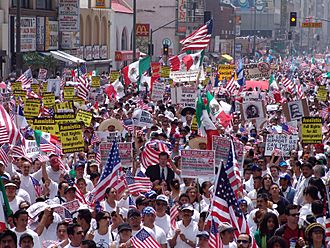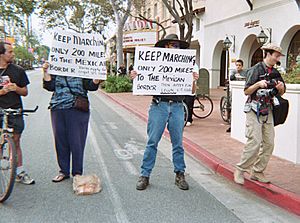Great American Boycott facts for kids
 |
|
| Date | May 1, 2006 |
|---|---|
| Location | United States, nationwide |
| Type | Demonstration |
| Theme | Immigrants rights |
| Participants | ~1,000,000 |
The Great American Boycott, also known as the Day Without an Immigrant, was a large one-day protest in the United States. It happened on May 1, 2006. During this event, many immigrants, mostly from Latin America, chose not to go to schools or businesses.
Organizers picked May 1 because it is International Workers' Day in many parts of the world, like Asia, Europe, and Mexico. The United States does not officially celebrate this day. Instead, it has Labor Day in September.
This boycott was part of bigger protests about immigration laws in 2006. People were asked to avoid buying, selling, working, and attending school. The goal was to show how much the country relies on the work of immigrants, including those without legal papers. Supporters gathered in cities across the US. They asked for ways for undocumented immigrants to become legal residents. This is why it was called "A Day Without an Immigrant," like the movie A Day Without a Mexican.
Most of the protests were peaceful. However, a rally in Vista, California became violent when some people threw objects at police. Two arrests were also made at a protest in Los Angeles.
Internationally, some labor unions and groups in Mexico and Central American countries supported the boycott. They called for a "Nothing Gringo Boycott" of US products. However, this international boycott did not have a big effect on the US economy.
Contents
Why the Boycott Happened
The idea for the boycott was announced on April 10, 2006. It came from a group in Los Angeles, California, called the March 25 Coalition. This group included Catholic organizations, immigrant rights groups, and labor unions. Other groups quickly joined in. The May Day Movement for Worker & Immigrants Rights helped coordinate the event across the country.
The Coalition formed because of protests against a proposed law called H.R. 4437. This bill was passed by the United States House of Representatives in December 2005. It would have made living in the US without legal papers a serious offense. It also wanted to punish people who hired or helped undocumented noncitizens. The bill also planned to build new fences along parts of the Mexico–United States border.
The bill did not become a law because it did not pass in the United States Senate. The March 25 Coalition got its name from a big protest on March 25, 2006. On that day, over 500,000 people protested in Los Angeles. Hundreds of thousands more protested in other US cities. These protests were known for being peaceful.
According to The New York Times, the boycott idea started with a small group in Los Angeles. They were inspired by the farmworker movement of the 1960s, led by César Chávez. They used the internet and immigrant media to spread the word. They worked with unions and immigrant rights groups to plan events for the boycott. These events were timed to happen on International Workers' Day.
Protests Across the Country
Local groups were in charge of organizing events in different cities. Sometimes, different groups planned separate events in the same city. Here are some of the major protests:
- Atlanta – About 2,500 protesters attended the event. Police had expected many more.
- Chicago – Police estimated that 400,000 people marched in Chicago. Organizers said the number was closer to 700,000. People from many backgrounds, including Polish, Irish, Asian, and African, joined the Latino marchers.
- Inland Empire – In Riverside, about 3,000 people marched to the county building. In San Bernardino, 1,500 people gathered at City Hall. Many local businesses closed for the day. Schools in the area saw more student absences.
- Las Vegas – More than 10,000 people walked about 5 miles along Las Vegas Boulevard.
- Los Angeles – Between 1 and 2 million people marched in two separate events. One march started in Downtown Los Angeles and was organized by the Mexican American Political Association. The second march was organized by the "We Are America" coalition, which included religious groups and labor organizations. The boycott had a big effect on the Latino community and Southern California. Businesses closed, traffic was heavy, and most of the daily traffic from the Port of Los Angeles stopped.
- Milwaukee – Nearly 70,000 people marched through downtown Milwaukee. This was more than double the number from a similar event a few weeks earlier. Mayor Tom Barrett spoke at the rally, praising the peaceful fight for justice. The head of the Wisconsin Restaurant Association also spoke about how important immigrants are to the restaurant industry. Many American flags were seen, and people were asked to put away flags from other nations. About 200 Milwaukee businesses closed for the day.
- New York City – Over 200,000 people marched from Chinatown to Federal Plaza. The march was led by many different worker and immigrant groups. Jesse Jackson was one of the leaders. Few stores closed for the boycott.
- Orange County, California – Most businesses stayed open. Between 8,000 and 10,000 people marched in Santa Ana. Two protesters were arrested after objects were thrown at police. Some schools reported slightly higher absences.
- San Francisco – Over 200,000 people marched from Justin Herman Plaza to City Hall. Many churches, labor groups, and community organizations helped organize the event.
- Santa Fe/Albuquerque – Rallies were organized by Somos un Pueblo Unido, an immigrant-advocacy group. Many businesses closed in both cities.
- San Rafael, California – An immigrant advocacy group called Canal Alliance held two events. About 3,000 people gathered in the downtown area.
- Santa Barbara, California – Many businesses, especially in Latino areas, closed. About one-third of students in the Santa Barbara School District did not attend classes. Many of them marched to City Hall. The main rally attracted about 15,000 supporters.
- Seattle – Around 20,000 to 30,000 people marched from the central district to the Federal Building downtown.
- Tampa/St. Petersburg – The biggest rallies in Florida were in Hillsborough County. About 12% of middle and high school students were absent. Several tomato farms closed because workers did not show up.
- Washington, D.C. – Some businesses closed, and more people than usual were absent from work. However, the overall impact on businesses was small.
People Against the Boycott

Republican congressman Tom Tancredo said that groups supporting illegal immigration put pressure on elected officials. He believed that Americans wanted secure borders, not amnesty.
Some people organized counter-demonstrations, but they were usually small. Some encouraged people to buy from American businesses to lessen the boycott's economic impact. For example, radio hosts John and Ken held a "Great American Spend-a-Lot" contest.
The Minuteman Project, a group that monitors the US-Mexican border, held rallies after the boycott. They also started building a barbed wire fence along the border in Arizona. The founder, Jim Gilchrist, said that large marches with Mexican flags were a form of intimidation.
A new group called 'You Don't Speak For Me' was formed. They wanted to show that the May 1 protesters did not speak for all Hispanic people. Pete Nunez, a spokesperson for the group, said that many Hispanic-Americans who followed immigration laws were offended by the demands of those who broke the laws.
CNN's Lou Dobbs criticized the boycott because some groups promoting it, like ANSWER (Act Now to Stop War and End Racism), were seen as radical. Dobbs also pointed out that May 1 is a day for demonstrations by socialist, communist, and anarchist groups worldwide.
The Washington Post suggested that the removal of the mayor and two council members in Herndon, Virginia, after they supported a day-labor center, was a negative reaction to the boycott. Some Southern and Western states created tougher laws against illegal immigration. The Post also said that the backlash from the boycott helped pass laws in the Arizona legislature that punished businesses hiring undocumented immigrants. Georgia also passed a law that prevents undocumented immigrants from getting many social services. It also requires police and employers to report undocumented workers.
Fox News host Sean Hannity questioned why people who did not respect US laws were demanding to stay. He also asked why those who disagreed were called racist.
Conservative writer Cinnamon Stillwell said that the boycott showed that the country could function without the labor of undocumented immigrants. She believed that while some people might have been inconvenienced, the economy did not stop.
What Happened Next
The boycott brought attention to the concerns of millions of people in the United States. It also highlighted the strong feelings about immigration.
On May 15, 2006, President Bush announced plans to send up to 6,000 National Guard troops to help secure the Southern US border.
On May 25, 2006, the US Senate approved its own immigration reform bill. This bill would have given some undocumented immigrants a chance to become citizens and would have strengthened border security. However, no agreement was reached between the Senate's bill and H.R. 4437 before the election in November.
Images for kids
See also
 In Spanish: Gran Paro Estadounidense para niños
In Spanish: Gran Paro Estadounidense para niños








